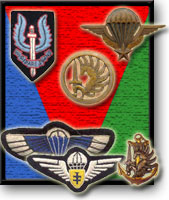Uniforms Overview
There are basically 3 sources for uniforms and equipment worn and used by the French paras during the war in Indochina. These are French, British and American
British Origin
The majority of the first parachute troops sent out to reclaim Indochina were equipped from British sources. Many had served in the 2 French SAS regiments in WW2. As France was rebuilding her manufacturing infrastructure after the destruction it had suffered there was a pressing need to use any available supply to equip her forces. There was a great deal of material no longer needed by the Western allies now that peace was declared in Europe and so much surplus equipment (uniforms, arms, webbing, vehicles etc) was available to purchase.
Amongst the most common items that were used by the expeditionary corps and later units were the camouflaged windproof suit (known as "peau de saucisson", sausage skins!), the Denison smock, the aertex battledress blouse in both jungle green (JG) and khaki drill (KD) and their associated trousers.
Headwear included the JG beret, the late war jungle hat, the Mk II "Tommy" helmet and the airborne helmet. The felt bush hat, both British and Australian patterns, was also worn early in the war.
US Origin
As the war progressed the British equipment and uniforms were gradually superceeded by US items, though never entirely replaced - for example the Windproof suit would be worn to the end of the war.
Popular items (amongst the para units) were the USMC and US Army camouflaged uniforms, the 2 piece HBT uniform, the HBT coverall and the M43 jacket.
The M43 buckle boot was widely distributed and used and there was limited use of the famous Corcoran jump boot.
Perhaps the most pervasive item of US uniform was the M1 steel helmet. It was used in the standard form and the paratrooper pattern (usually the M1C). However nothing is ever that straight forward and it was quite common (almost the rule) to see standard M1 helmet shells worn with paratroop liners, or with a locally fabricated chinstrap system.
French Origin
From about 1949 the supply of French designed and made material increased. Perhaps the most obvious of these being the TAP Mle 50 webbing equipment system and the various patterns of jump suit (Tenue de Saut).
The jump suits were made in a number of patterns and in both Khaki and camouflage. Intially issued in 1947 the uniform was a fusion of the US M42 jump suit and the British Denison smock.


